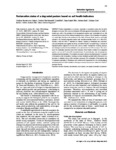Por favor, use este identificador para citar o enlazar este ítem:
http://www.alice.cnptia.embrapa.br/alice/handle/doc/1020077Registro completo de metadatos
| Campo DC | Valor | Lengua/Idioma |
|---|---|---|
| dc.contributor.author | SANTOS. C. A. dos | pt_BR |
| dc.contributor.author | KRAWULSKI, C. C. | pt_BR |
| dc.contributor.author | BINI, D. | pt_BR |
| dc.contributor.author | GOULART FILHO, T. | pt_BR |
| dc.contributor.author | KNOB, A. | pt_BR |
| dc.contributor.author | MEDINA, C. C. | pt_BR |
| dc.contributor.author | ANDRADE FILHO, G. | pt_BR |
| dc.contributor.author | NOGUEIRA, M. A. | pt_BR |
| dc.date.accessioned | 2015-07-20T11:11:11Z | pt_BR |
| dc.date.available | 2015-07-20T11:11:11Z | pt_BR |
| dc.date.created | 2015-07-20 | pt_BR |
| dc.date.issued | 2015 | pt_BR |
| dc.identifier.citation | Scientia Agrícola, Piracicaba, v. 72, n. 3, p. 195-202, May/Jun. 2015. | pt_BR |
| dc.identifier.issn | 0103-9016 | pt_BR |
| dc.identifier.uri | http://www.alice.cnptia.embrapa.br/alice/handle/doc/1020077 | pt_BR |
| dc.description | Pasture degradation is a concern, especially in susceptible sandy soils for which strategies to recover them must be developed. Microbiological and biochemical soil health indicators are useful in the guindace of soil management practices and sustainable soil use. We assessed the success of three Panicum maximum Jacq. cultivars in the reclamation of a pasture in a sandy Typic Acrudox in the northwest of the state of Paraná, Brazil, based on soil health indicators. On a formerly degraded pasture with Urochloa brizantha (Hochst. ex A. Rich.) R.D. Webster, a trial with three P. maximum (cv. Massai, Tanzânia, or Mombaça) was conducted. Lime and phosphate were applied at set-up, and mineral N and K as topdressing. A remnant of degraded pasture adjacent to the trial was used as control. Twenty-three chemical, physical, microbiological and biochemical attributes were assessed for the 0-10 cm topsoil. The procedures for reclamation improved most of the indicators of soil health in relation to the degraded pasture, such as soil P, mineral N, microbial biomass C, ammonification rate, dehydrogenase activity and acid phosphatase. CO2 evolution decreased, whereas microbial biomass C increased in the pasture under reclamation, resulting in a lower metabolic quotient (qCO2) that points to a decrease in metabolic stress of the microbial community. The reclamation of the pasture with P. maximum, especially cv. Mombaça, were evidenced by improvements in the microbiological and biochemical soil health indicators, showing a recovery of processes related to C, N and P cycling in the soil. | pt_BR |
| dc.language.iso | por | pt_BR |
| dc.rights | openAccess | pt_BR |
| dc.title | Reclamation status of a degraded pasture based on soil health indicators. | pt_BR |
| dc.type | Artigo de periódico | pt_BR |
| dc.date.updated | 2017-09-11T11:11:11Z | pt_BR |
| dc.subject.thesagro | Química do solo | pt_BR |
| dc.subject.thesagro | Fertilidade do solo | pt_BR |
| dc.subject.thesagro | Física do solo | pt_BR |
| dc.subject.nalthesaurus | Soil physical properties | pt_BR |
| dc.subject.nalthesaurus | Soil chemical properties | pt_BR |
| dc.subject.nalthesaurus | Soil fertility | pt_BR |
| riaa.ainfo.id | 1020077 | pt_BR |
| riaa.ainfo.lastupdate | 2017-09-11 -03:00:00 | pt_BR |
| dc.identifier.doi | 10.1590/0103-9016-2013-0274 | pt_BR |
| dc.contributor.institution | CRISTIANE ALCANTARA DOS SANTOS; CRISTINA CÉLIA KRAWULSKI, EMATER Londrina; DANIEL BINI, UNICENTRO; TADEU GOULART FILHO, UEL; ADRIANA KNOB; CRISTIANE CONTI MEDINA, UEL; GALDINO ANDRADE FILHO, UEL; MARCO ANTONIO NOGUEIRA, CNPSO. | pt_BR |
| Aparece en las colecciones: | Artigo em periódico indexado (CNPSO)  | |
Ficheros en este ítem:
| Fichero | Descripción | Tamaño | Formato | |
|---|---|---|---|---|
| nogueirareclamationstatus....pdf | 214.34 kB | Adobe PDF |  Visualizar/Abrir |









